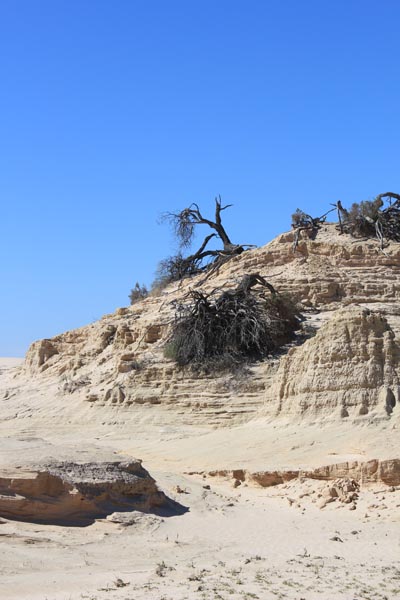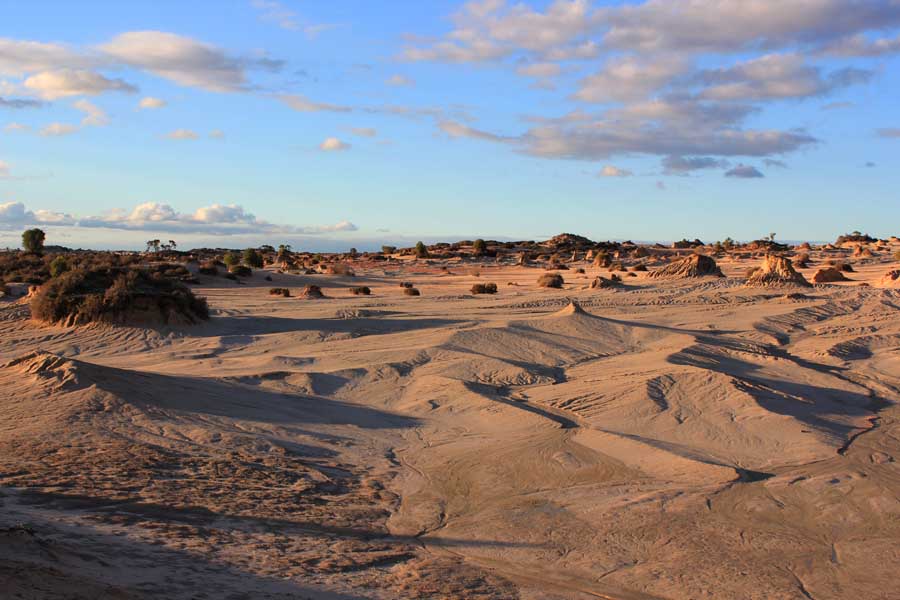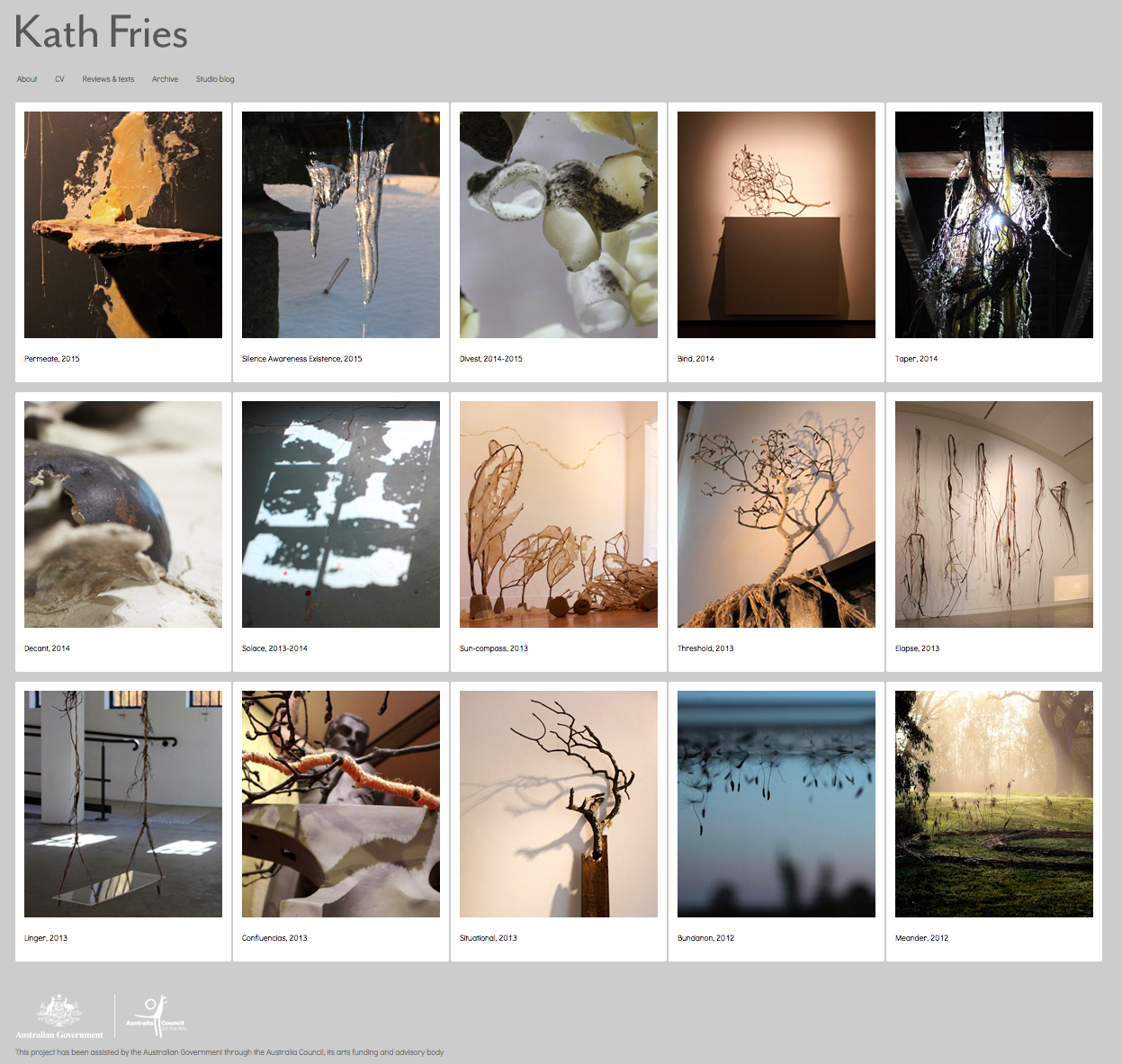 |
| Kath Fries, Mungo landscape i, 2015, photograph |
Last week I drove 900km west from Sydney to the dry ancient lakebeds of Mungo National Park, with artist Shoufay Derz and
musician Emily Rice. As night fell it began to rain heavily and our car slowed
to a crawl, frequently stopping to wait for the thirsty kangaroos and echidnas
drinking from the puddles forming in the ruts of the unsealed dirt road. Around
midnight we settled into our accommodation in the old Shearer's Quarters,
knowing that we would be stranded there for couple of days, as the unsealed
clay roads became boggy, slippery and completely impassable in the rain. After our long journey we were glad to have arrived and not concerned about
having to stay an extra night in this magical, quiet, ancient place. It was a fascinating
place to just be. We were quite lucky to see this wonderful desert landscape in the unusual wet
weather - the last big rainfall was in 2011. There was a significant amount of water, but it was soon
vanquished by baking sunshine and blistering winds, drying the landscape,
vegetation and roads. Then, as each day passed the park rangers re-opened a section of the loop
road so we were eventually able to visit all the main sites and rock
formations.
 |
| Kath Fries, Big puddle in Mungo, 2015, photograph |
Mungo is one of the most ancient parts of Australia and
buried in its thick layers of sand and clay is significant evidence of changes
in climate, waters and landforms spanning the last 100,000 years. This geology
is both fragile and robust, quiet and resonant, as the layers of sediment have
washed and accumulated, piling up with narratives of historical time and place.
Dreamtime-stories and scientific-rationality not only meet on these dry
ancient lakebeds, but they coalesce and find common ground. Mungo's layers of
clay have revealed significant evidence of human habitation dating back over
50,000 years across expanses of the last ice age, so Mungo is one of the oldest
places outside of Africa to have been occupied by modern humans since ancient
times. “The ancient Willandra people thrived with the abundance of the lakes,
then adapted to drier, hungrier times of the last ice age and survived to the
present day. Their story can be discovered in the folds of the land, along with
their fireplaces, burials, middens and tools.” (link)
 |
| Kath Fries, Mungo landscape ii, 2015, photograph |
As tourists visiting Mungo, we were understandably confined
to the boardwalks, unlikely to recognise or appreciate the subtle traces of these stories in
the land or see the slight differences between ancient mega-fauna fossilised
bones and those of recently deceased kangaroos. Although as artists, we had our
own ways of being receptive and sensitive to the intense and ancient presence
of our surroundings. But it was somewhat difficult to match this with the dry
scientific and pastoral histories conveyed via the information panels and
diagrams of the visitors centre. However, over the course of several
conversations with Tanya - traditional custodian and Mungo
park ranger - the depth, breadth and resonance of the site came alive.
 |
| Kath Fries, Mungo landscape iii, 2015, photograph |
Towards the end of our visit, the night skies cleared and we
walked a short distance from the campfire pit and the buildings’ few solar
powered lights, to lie on the road and look at the stars that stretched from
horizon to horizon in every direction, a vast dome around us. For the first
time I could clearly see the Emu - a definitive symbol of Aboriginal Astronomy, which Tanya had described to us earlier in the day. The Emu
isn’t a pattern connecting the stars themselves, but rather the darkness of the
dark dust lines between the dense stars of the Milky Way, which forms the shape
of the Emu and its egg (link). The Emu changes orientation and shape somewhat with the
seasons and these changes tell Aboriginal people the correct time to collect
emu eggs. During the daytime, we saw about eight wild emus, flouncing their
fabulous long tail feathers running through Mungo’s saltbush and scrub. Tanya
told us that the ones we saw were female, as at this time of year the males are
sitting on the nests minding the eggs.
 |
| Kath Fries, Mungo clay and sand patterns, 2015, photograph |
At night sitting outside around the warm smoky campfire-pit,
under those stars, sharing stories with other visitors staying at the Shearer’s
Quarters, I felt the prickling’s of a spooky presence watching over
our shoulders from the vast dark landscape around us. Indeed there were ancient
burial grounds not far away. Famously 40,000-year-old remains of a woman were
discovered at Mungo, in 1968. Dubbed the ‘Mungo Lady’, she is the oldest
demonstrated ritual cremation anywhere in the world. She is a crucial ancient
link to the rituals and emotions of people living in this area so long ago, and literally embodies the importance of death and grieving that remains so core to our
understanding of what it is to be human. The 'Mungo Lady's' bones were exposed by erosion, so she wasn't as much discovered as revealed, a gift from the land and the spirits. Her bones were taken from Mungo by the archeologists, but after considerable lobbying from local Aboriginal groups, she was returned to the area and her continued
presence is immensely profound. I was fascinated to hear from Tanya, that her
Nana had been a key spokesperson in the negotiations and respectful handling of
this delicate and sensitive episode, making clear that ‘Mungo Lady’ is her
ancestor and part of her family. This strong interconnection with people, place
and past continues to be very powerfully felt, and the sense of the 'Lady’s' spirit watching over the Mungo region permeates how all humans – visitors,
scientists, archaeologists, locals and traditional owners – engage with this
ancient site.
 |
| Kath Fries, Mungo landscape iv, 2015, photograph |
More recently, in 2003, ancient perfectly preserved human
footprints were revealed beneath the shifting sands of Mungo. The twenty-five
trackways are about 20,000 years old, the oldest footprints ever found in
Australia and the largest set of Pleistocene ice age footprints in the world. After
being thoroughly documented and researched by the traditional owners, scientists
and archaeologists, the trackways were then considerately reburied. It would be
impossible to try and remove the imprints or leave them uncovered, if they had
been left exposed to the elements, animals and humans, the trackways would
have quickly disintegrated. It was agreed that the best place for these
precious records to be kept was in the exact same environment that has
preserved them for so long. I think there is something poetically wonderful
that these extremely valuable treasures have been reburied with only an 'X' marking the spot on the geophysical maps and in people's memories who can read the land. (link)
 |
| Kath Fries, Mungo landscape v, 2015, photograph |
The fragile shifting surface of Mungo is like a constantly
changing skin, growing and shedding, rising and falling, which contains and
protects the powerful vitality of resilience and presence beneath. To feel the abrasive
sandblasting wind blowing against my face as it skidded across Mungo’s clay layers, and witnessing the alarmingly quick way that the exposed
clay dissolved in the rain, was an evocative experience of impermanence. Reflecting on what I could not see, but had been told, about the burial grounds and ancient bodily remains of humans and animals
contained and protected within the clay, then briefly whisked to the surface to
see the light of day in my own lifetime, conjures further notions
of embodied existence and interconnection between the known and unknown. Aboriginal elders, scientists and archaeologists agree that there
are even more fossils, trackways and precious ancient history hidden within the
layers of clay.
 |
| Kath Fries, Mungo Kangaroos, 2015, photograph |
Today, Mungo is a landscape that reveals its history in
its own time, rather than people purposefully setting out to dig it up. The
land and weather have their own agency, timeframe, purposefulness and ways of responding. Traditional custodians and Aboriginal Elders are teaching visitors and scientists that there are
certain ways of patiently listening to the land and learning from it. I feel fortunate to have
experienced a mere inkling of the traces of history and presence in the
landscape at Mungo, which was quite profound, effecting and unique to that place.
 |
| Kath Fries, Mungo landscape vi, 2015, photograph |
The dissolving rains and buffering, blistering winds that
sandblasted my skin – as well as the surface of the land, emphasised how easily
this ancient, fragile and robust environment changes. There were many nuances in
my personal present-time encounter with Mungo, the sense of constant gradual
changes and shifts, being traced and imprinted on the surfaces of the
landscape, feel like they have also left an imprint on me.




























%2BWhite%2C%2BBRANCH%2B3d.jpg)














.jpg)














